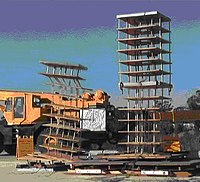
Photo from wikipedia
Fibre-reinforced polymers (FRPs) and textile-reinforced concretes (TRCs) are becoming increasingly common solutions for strengthening masonry walls. This study focuses on different approaches for modelling the behaviour of hollow concrete block… Click to show full abstract
Fibre-reinforced polymers (FRPs) and textile-reinforced concretes (TRCs) are becoming increasingly common solutions for strengthening masonry walls. This study focuses on different approaches for modelling the behaviour of hollow concrete block masonry walls strengthened with FRPs and a TRC subjected to in-plane loading. Specifically, the masonry is modelled using the heterogeneous approach, wherein the damage post-peak softening behaviours of both bricks and mortar are considered, as this approach is appropriate for material and structure scales. To model the FRP/TRC-reinforced masonry walls, the reinforcements (FRPs/TRC) are perfectly connected to the substrate. Although the homogeneous approach is proposed to model the FRPs with linear elastic behaviour and is shown to be appropriate for modelling the FRP-reinforced masonry walls, the TRC is modelled using the heterogeneous approach, allowing for the real contribution of the filaments to be expressed through an ‘efficiency factor’. The numerical results show that this factor has a significant influence on the behaviour of the TRC and therefore, on the overall behaviour of the TRC-reinforced walls. However, the ‘efficiency factor’ of the TRC sample is significantly higher than that of the TRC in the strengthened wall. This result confirms that the choice of the heterogeneous approach to model the TRC in our case is appropriate. Moreover, it verifies that it is impossible to transpose this global factor from the material scale (uniaxial tensile stress) to the structure scale when the application target is a masonry wall (multi-axiality, and therefore, complexity of the stress). Consequently, the constitutive laws of the TRC composite obtained through only direct uniaxial tensile characterization procedures are insufficient to enable a suitable restitution of the overall behaviour of the masonry reinforced with the TRC. In addition, regardless of the nature of the reinforcement, the overall behaviours of the masonry walls reinforced with the FRPs/TRC are governed by both the axial stiffness of the reinforcement and the compressive strength of the masonry substrate.
Journal Title: Journal of Composite Materials
Year Published: 2021
Link to full text (if available)
Share on Social Media: Sign Up to like & get
recommendations!